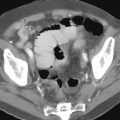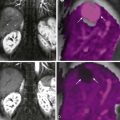Chapter Outline
Congenital Esophageal Stenosis
Mallory-Weiss Tear
Pathogenesis
A Mallory-Weiss tear is recognized as a relatively common injury in which a sudden, rapid increase in intraesophageal pressure produces a linear mucosal laceration at or near the gastric cardia. These tears are usually caused by violent retching or vomiting after an alcoholic binge or by protracted vomiting for any reason. Less commonly, Mallory-Weiss tears may be caused by prolonged hiccuping or coughing, seizures, straining at stool, childbirth, or blunt abdominal trauma. Similar injuries may also result from direct laceration of the mucosa by an advancing endoscope or by a sharp foreign body in the esophagus, such as a taco.
Clinical Findings
Mallory-Weiss tears account for 5% to 10% of all cases of acute upper gastrointestinal (GI) bleeding. Some patients may have massive hematemesis, but most tears heal spontaneously within 48 to 72 hours, so bleeding is usually self-limited. These patients therefore have an excellent prognosis with an overall mortality rate of only about 3%. Although most patients can be managed conservatively, selective intra-arterial infusion of vasopressin, transcatheter embolization, endoscopic electrocoagulation, or surgical repair of the tear may occasionally be required to control bleeding.
Radiographic Findings
The vast majority of Mallory-Weiss tears are diagnosed at endoscopy. Nevertheless, these mucosal lacerations are occasionally recognized on double-contrast esophagograms as shallow, longitudinally oriented, linear collections of barium in the distal esophagus at or just above the gastroesophageal junction ( Fig. 25-1 ). The radiographic appearance may be indistinguishable from that of a linear ulcer in the distal esophagus caused by reflux esophagitis, but a history of recent vomiting or hematemesis (particularly in alcoholics) should suggest the correct diagnosis.
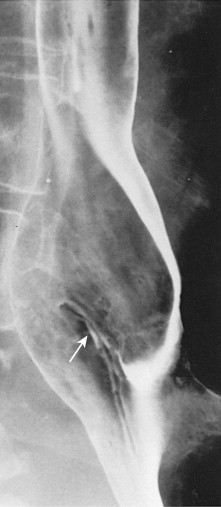
Esophageal Hematoma
Pathogenesis
Most esophageal hematomas are caused by a mucosal laceration or tear in the distal esophagus. If the tear is partially or completely occluded by edema or blood clot, continued hemorrhage may lead to progressive submucosal dissection of blood, producing an intramural hematoma. As with Mallory-Weiss tears, the underlying laceration is usually caused by a sudden increase in intraesophageal pressure resulting from one or more episodes of violent retching or vomiting. Esophageal hematomas may also be caused by esophageal instrumentation or, rarely, by blunt trauma. Occasionally, spontaneous hematomas may develop in patients who have impaired hemostasis because of thrombocytopenia, bleeding disorders, or anticoagulation. In contrast to traumatic hematomas, which almost always occur as solitary lesions in the distal esophagus, spontaneous hematomas tend to spare the distal esophagus and are more likely to be multifocal.
Clinical Findings
Patients with esophageal hematomas usually present with severe chest pain, dysphagia, or hematemesis. Despite the dramatic clinical findings, most esophageal hematomas resolve in 1 to 2 weeks on conservative treatment without need for surgery. These lesions should therefore be considered self-limited because they almost never progress to complete transmural perforation.
Radiographic Findings
Esophageal hematomas usually appear on barium studies as solitary submucosal masses in the distal esophagus that are indistinguishable from leiomyomas or other benign intramural lesions ( Fig. 25-2 ). When a mucosal laceration is present, however, barium may dissect beneath the mucosa into the hematoma. This intramural dissection produces a characteristic double-barreled appearance caused by parallel collections of contrast material in true and false lumens separated by a thin, radiolucent stripe ( Fig. 25-3 ). Rarely, a double-barreled appearance may also be caused by intramural tracking of barium secondary to Crohn ‘ s disease, Candida esophagitis, tuberculous esophagitis, or esophageal intramural pseudodiverticulosis.
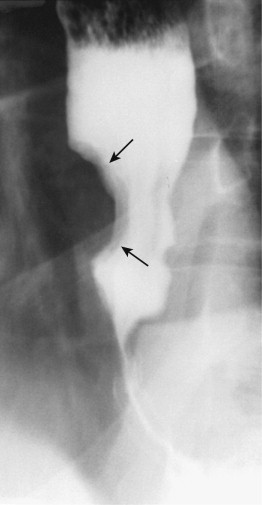
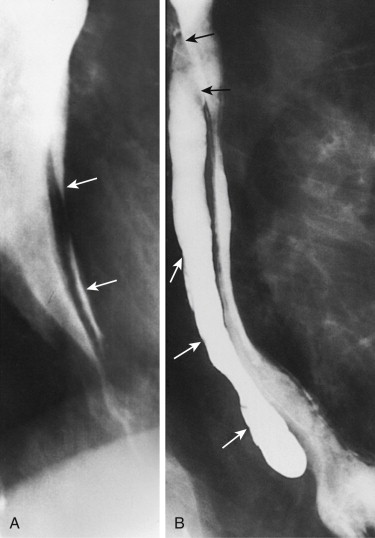
Esophageal hematomas may be recognized on CT by the presence of a well-defined intramural mass, which sometimes has a tubular appearance, extending a considerable distance along the long axis of the esophagus. If the hematoma is acute or subacute, hyperdense areas may be present within the lesion.
Esophageal Perforation
Esophageal perforation is the most serious and rapidly fatal type of perforation in the GI tract. Untreated thoracic esophageal perforations have a mortality rate of almost 100% because of the fulminant mediastinitis that occurs after esophageal rupture. Perforation of the cervical esophagus is a more common but less devastating injury. Early diagnosis of esophageal perforation is important because of the potential need for prompt surgical intervention.
Pathogenesis
Instrumentation
Endoscopic procedures are responsible for up to 75% of all esophageal perforations. This complication occurs in about 1 in 3000 patients who undergo endoscopic examinations with modern fiberoptic instruments. Most endoscopic perforations involve the piriform sinus or cricopharyngeal region in which the posterior wall of the pharyngoesophageal junction is compressed by the advancing endoscope against the cervical spine. The presence of cervical osteophytes or a pharyngeal diverticulum increases the risk of perforation. Unlike cervical esophageal perforations, which often occur in the absence of underlying disease, thoracic esophageal perforations usually result from endoscopic injury at or above esophageal strictures or from therapeutic maneuvers such as variceal sclerotherapy, balloon dilation, bougienage, stent or nasogastric tube placement, and foreign body removal. Perforation may also occur after esophageal surgery, usually at the site of a ruptured anastomosis (see Chapter 27 ).
Foreign Bodies
Most foreign body perforations in adults are caused by impacted animal or fish bones in the hypopharynx that erode through the piriform sinus or cricopharyngeal region. Rarely, foreign body obstructions in the thoracic esophagus also lead to perforation as a result of transmural inflammation and pressure necrosis at the site of impaction (see later, “ Foreign Body Impaction ”). Esophageal perforation may also be caused by accidental or intentional ingestion of caustic agents (see Chapter 21 ).
Trauma
Penetrating injuries to the esophagus are usually caused by knife or bullet wounds. Because the neck lacks the bony protection afforded by the thorax, these injuries generally involve the cervical esophagus. Rarely, blunt trauma to the neck, chest, or abdomen can also lead to pharyngeal or esophageal perforation or transection (see next section).
Spontaneous Esophageal Perforation (Boerhaave ‘ s Syndrome)
In spontaneous esophageal perforation, a sudden, rapid increase in intraluminal esophageal pressure causes a full-thickness perforation of normal underlying esophageal tissue, with ensuing mediastinitis, sepsis, and shock. Most cases result from violent retching or vomiting, usually after an alcoholic binge. Occasionally, however, spontaneous rupture of the esophagus may result from other causes of increased intraesophageal pressure, such as coughing, weightlifting, childbirth, defecation, seizures, status asthmaticus, and blunt trauma to the chest or abdomen.
Spontaneous esophageal perforations usually occur as 1- to 4-cm long, vertically oriented, linear tears on the left lateral wall of the distal esophagus just above the gastroesophageal junction. The left side of the distal esophagus is more vulnerable to perforation because of the lack of supporting mediastinal structures in this region, whereas the right side of the distal esophagus is protected by the descending thoracic aorta. Rarely, spontaneous perforation of the upper thoracic esophagus or even the cervical esophagus has been reported.
Clinical Findings
Cervical Esophageal Perforation
Most cervical esophageal perforations occur as direct complications of endoscopy. Affected individuals may develop neck pain, dysphagia, or fever. Physical examination often reveals subcutaneous emphysema in the neck as a result of gas escaping from the pharynx into the adjacent soft tissues. If untreated, these patients may develop a retropharyngeal abscess, occasionally leading to sepsis and shock.
Cervical esophageal perforations often heal on conservative management, so most small perforations can be treated nonoperatively. However, larger perforations may require a cervical mediastinotomy and open drainage to prevent abscess formation. These injuries have a much better prognosis than thoracic esophageal perforations, with an overall mortality rate of less than 15%.
Thoracic Esophageal Perforation
Patients with thoracic esophageal perforation may present with the classic triad of vomiting, substernal chest pain, and subcutaneous emphysema of the chest wall and neck. However, some patients have atypical chest pain referred to the left shoulder or back, whereas others have epigastric pain, particularly if the perforation involves the intra-abdominal segment of the esophagus below the diaphragmatic hiatus. Furthermore, subcutaneous emphysema is not always present on physical examination. As a result, thoracic esophageal perforation can be mistaken for a variety of acute cardiothoracic or abdominal conditions. Signs or symptoms of esophageal perforation can also be masked by treatment with steroids. This clinical confusion sometimes leads to delayed diagnosis and treatment of a life-threatening condition. Unfortunately, the mortality rate for thoracic esophageal perforation approaches 70% by 24 hours. Thus, early diagnosis is essential for improving patient survival.
Unlike cervical esophageal perforations, which are often treated conservatively, thoracic esophageal perforations may require an emergent thoracotomy (with surgical closure of the perforation and mediastinal drainage) to prevent the development of mediastinitis, sepsis, and death. More recently, thoracic esophageal perforations have also been treated successfully with occlusive, removable esophageal stents, obviating the need for surgery. Rarely, thoracic esophageal perforations associated with Boerhaave’s syndrome may heal spontaneously without intervention. Other small, self-contained perforations can sometimes be managed nonoperatively with broad-spectrum antibiotics.
Radiographic Findings
Plain Radiographs
Cervical Esophageal Perforation.
Subcutaneous emphysema or retropharyngeal gas may be visible on anteroposterior or lateral radiographs of the neck within 1 hour after a pharyngeal or cervical esophageal perforation ( Fig. 25-4A ). Subsequently, air may dissect along fascial planes from the neck into the chest, producing pneumomediastinum (see Fig. 25-4A ). Lateral radiographs of the neck may also demonstrate widening of the prevertebral space, anterior deviation of the trachea and, eventually, a retropharyngeal abscess containing mottled gas or a single air-fluid level.
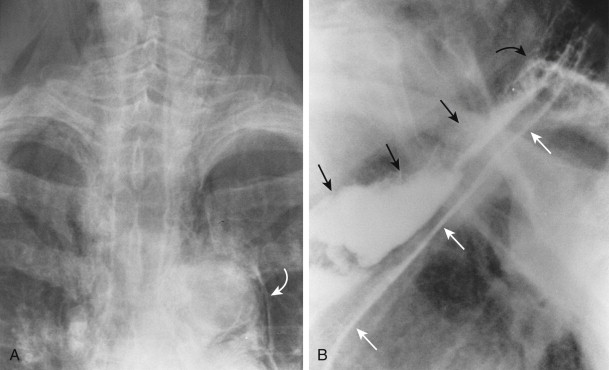
Thoracic Esophageal Perforation.
About 90% of patients with thoracic esophageal perforations have abnormal chest radiographs. The earliest signs of perforation include mediastinal widening and pneumomediastinum; the latter finding is usually recognized by the presence of radiolucent streaks of gas along the left lateral border of the aortic arch and descending thoracic aorta or along the right lateral border of the ascending aorta and heart ( Fig. 25-5A ). Subsequently, gas in the mediastinum may dissect along fascial planes superiorly to the supraclavicular area, producing subcutaneous emphysema in the neck within several hours of the perforation.
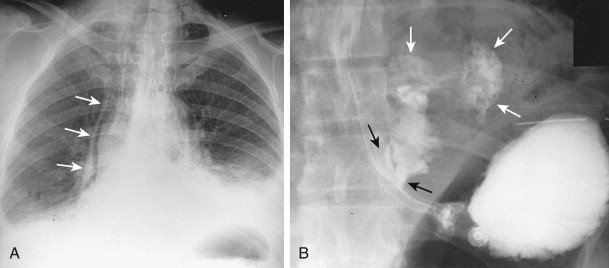
At least 75% of thoracic esophageal perforations are associated with a pleural effusion or hydropneumothorax. Distal perforations often result in a sympathetic left pleural effusion or left basilar atelectasis because of irritation of the adjacent pleura and lung parenchyma (see Fig. 25-5A ). Pleural effusions may be present within 12 hours of perforation and are occasionally detected before the development of mediastinal or cervical emphysema. If the mediastinal pleura ruptures, gas and fluid may enter the pleural space directly from the mediastinum, producing a hydropneumothorax. Because the distal esophagus directly abuts the mediastinal pleura on the left, 75% of hydropneumothoraces are on the left side, whereas 5% are on the right and 20% are bilateral.
Rarely, abdominal radiographs may reveal extraluminal collections of gas in the lesser sac or retroperitoneum when the intra-abdominal segment of the distal esophagus is perforated below the diaphragmatic hiatus. Affected individuals may have vague abdominal discomfort without chest pain or other classic signs of esophageal perforation, so the diagnosis is often delayed in these patients. On the other hand, intra-abdominal esophageal perforations have a more benign clinical course, sometimes healing spontaneously on conservative treatment.
Fluoroscopic Examinations
Fluoroscopic esophagography is an excellent study for patients with suspected esophageal perforation. The ideal contrast agent for this examination provides diagnostic information about the site and extent of perforation without posing a risk to the patient. It has been shown experimentally that barium in the mediastinum is capable of inciting an inflammatory reaction with subsequent granuloma formation and fibrosis, but there is little or no evidence that mediastinal barium causes clinically significant mediastinitis. Although water-soluble contrast agents such as diatrizoate meglumine and diatrizoate sodium (Gastroview, Mallinckrodt, St. Louis) do not produce a detectable histologic response and have no known deleterious effects on the neck, mediastinum, and pleural or peritoneal cavities, water-soluble contrast media are hypertonic agents that are capable of causing severe pulmonary edema if aspirated into the lungs. On the other hand, barium that extravasates from the esophagus can remain in the mediastinum indefinitely, limiting the radiologist ‘ s ability to assess healing on follow-up fluoroscopic examinations. In contrast, water-soluble contrast agents are rapidly absorbed from the mediastinum, so follow-up studies are not compromised by residual extraluminal contrast medium at or near the site of perforation. This is the major rationale for using water-soluble contrast agents as the initial contrast media for the fluoroscopic evaluation of patients with suspected esophageal perforation. Alternatively, some investigators advocate the use of low-osmolality, water-soluble contrast agents such as iohexol (Omnipaque, GE Healthcare, Princeton, NJ) to decrease the risks of aspirated contrast material in the lungs. Others favor the use of barium as the initial contrast agent for patients with suspected esophageal perforation, particularly in patients who are at high risk for aspiration. When water-soluble contrast agents are used, the pharynx should be carefully observed at fluoroscopy, and the examination should be aborted if significant aspiration is detected during the initial swallow.
A major disadvantage of water-soluble contrast agents is that they are less radiopaque than barium and less adherent to sites of leakage, limiting their ability to depict perforations, particularly small or subtle perforations. In various studies, 50% of cervical esophageal perforations and up to 25% of thoracic esophageal perforations were missed on fluoroscopic examinations performed only with water-soluble contrast agents. When the initial study with water-soluble contrast medium fails to show a leak ( Fig. 25-6A ), the examination should therefore immediately be repeated with barium to detect subtle leaks that are more likely to be visualized with a more radiopaque contrast agent ( Fig. 25-6B ). Although low-density barium is able to visualize 22% to 38% of leaks missed on esophagograms performed with water-soluble contrast agents, high-density barium (i.e., the 250% w/v barium suspension used for double-contrast upper GI examinations) is capable of detecting 50% of leaks that are not visualized with water-soluble contrast agents because of the greater opacity of high-density barium. Leaks detected only with high-density barium are more likely to be characterized by small, blind-ending tracks or tiny extraluminal collections than those visualized with a water-soluble contrast agent, but patient management is still affected in most cases. High-density barium should therefore be used to optimize detection of esophageal perforation on fluoroscopic examinations when no leak is initially detected with a water-soluble contrast agent (see Fig. 25-6 ). In these cases, the downside of retained barium in the mediastinum is more than offset by the earlier diagnosis and treatment of a potentially life-threatening condition.
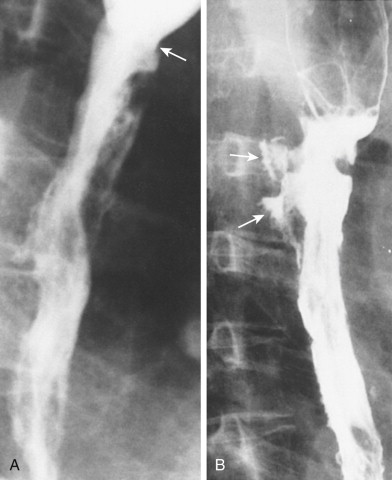
Esophageal perforations are recognized on esophagography by extravasation of contrast medium from the esophagus into the neck or mediastinum. In patients with spontaneous perforation (Boerhaave ‘ s syndrome), contrast medium is usually seen extravasating from the left lateral wall of the distal esophagus into the adjacent mediastinum (see Fig. 25-5B ). Rarely, spontaneous perforation of the upper thoracic or even the cervical esophagus may also be demonstrated ( Fig. 25-7 ). Regardless of the site of perforation, a sealed-off leak is usually manifested by a contained extraluminal collection that communicates with the adjacent lumen (see Figs. 25-6B and 25-7A ). In contrast, larger perforations may result in free extravasation of contrast medium into the mediastinum, with extension along fascial planes superiorly or inferiorly from the site of perforation (see Figs. 25-4B and 25-5B ). In patients with contained perforations, follow-up esophagograms may be obtained to document healing of the leak prior to initiating oral feeding (see Fig. 25-7B ).
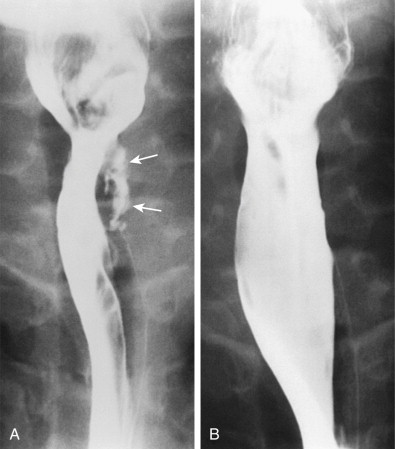
Computed Tomography
Computed tomography (CT) may also be performed on patients in whom esophageal perforation is suspected on clinical grounds. In such cases, the finding of extraluminal gas, fluid, or contrast material in the mediastinum should be highly suggestive of esophageal perforation ( Fig. 25-8 ). Pleural and pericardial fluid collections are other less specific findings. When a perforation is present, CT also is useful for determining the extent of extraluminal gas and fluid in the mediastinum and for monitoring patients who are treated nonoperatively. CT has been shown to be a more sensitive technique than fluoroscopic esophagography for detecting esophageal perforation, most likely because of its ability to show indirect signs of a leak after the leak has sealed off. Conversely, esophagography has a higher specificity than CT, particularly in the setting of previous surgery, in which variable amounts of residual gas and fluid may be present in the mediastinum in the absence of an actual leak. Another limitation of CT is its frequent inability to locate the exact site of perforation. At our institution, we generally perform fluoroscopic esophagography as the initial examination in patients with suspected esophageal perforation. If the findings on esophagography are equivocal or if esophagography fails to show a leak in patients with a high clinical suspicion for esophageal perforation, CT is performed to increase the sensitivity for detection of leaks.
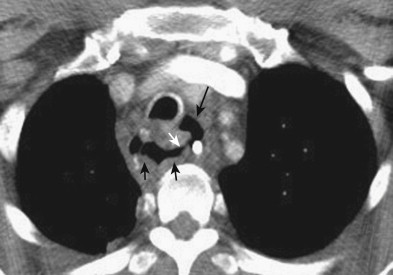
Foreign Body Impaction
Almost 80% of all pharyngeal or esophageal foreign body impactions occur in children who accidentally or intentionally ingest coins, toys, or other foreign objects. Foreign body impactions in adults are usually caused by animal or fish bones or inadequately chewed boluses of meat, vegetables, or other bulky food items. Bones tend to lodge in the pharynx near the level of the cricopharyngeus, whereas food usually lodges in the distal esophagus near the gastroesophageal junction. In contrast to impactions resulting from sharp foreign bodies, food impactions are often caused by underlying esophageal rings or strictures. Although 80% to 90% of foreign bodies in the esophagus pass spontaneously, the remaining 10% to 20% require some form of therapeutic intervention.
Clinical Findings
Animal or fish bones tend to lodge in the pharynx, often near the level of the cricopharyngeus. The patient may complain of pharyngeal dysphagia or of a sensation of a foreign body in the throat. In contrast, food impactions tend to occur in the distal esophagus and are manifested by the sudden onset of substernal chest pain, odynophagia, or dysphagia. Some patients with distal foreign body impactions have dysphagia that is referred to the pharynx, however, so the subjective site of obstruction is unreliable in determining the level of impaction.
Esophageal perforation occurs in less than 1% of all patients with foreign body impactions. However, the risk of perforation increases substantially if the impaction persists longer than 24 hours. Perforation results from transmural esophageal inflammation and subsequent pressure necrosis at the site of impaction. The development of mediastinitis may lead to sudden, rapid clinical deterioration, manifested by chest pain, sepsis, and shock. Rarely, an impacted foreign body can erode through the wall of the esophagus, producing an aortoesophageal, esophagobronchial, or esophagopericardial fistula (see later, “ Fistulas ”).
Radiographic Findings
Plain Radiographs
Anteroposterior and lateral radiographs of the neck and chest may occasionally demonstrate bones or other radiopaque foreign bodies in the pharynx or esophagus. Lateral radiographs of the neck are usually more helpful than anteroposterior radiographs in identifying animal or fish bones lodged in the pharynx or cervical esophagus ( Fig. 25-9 ) because these bones are easily obscured by the overlying cervical spine on anteroposterior radiographs. Nevertheless, considerable difficulty may be encountered in differentiating small bone fragments from calcified thyroid or cricoid cartilage.
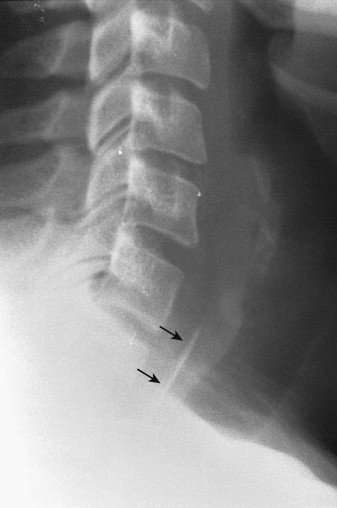
Fluoroscopic Examinations
In patients with suspected foreign body impaction in the pharynx or cervical esophagus, an early barium swallow may be performed to determine whether a foreign body is present and whether it is causing obstruction. Animal or fish bones in the pharynx or cervical esophagus are easily obscured by intraluminal barium, so they may be difficult to detect on fluoroscopic examinations. However, these foreign bodies are sometimes recognized as linear filling defects in the vallecula, piriform sinus, or cricopharyngeal region ( Fig. 25-10 ). Cotton balls or marshmallows soaked in barium may occasionally be helpful for showing bones lodged in the pharynx or cervical esophagus.
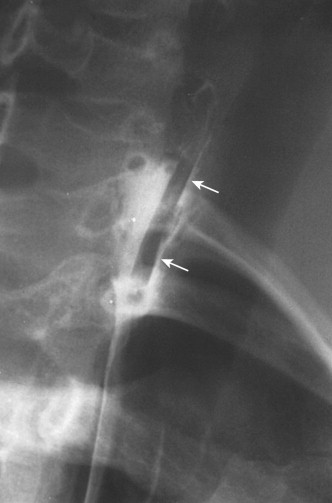
Foreign body impactions in the thoracic esophagus usually result from a large bolus of meat or other food that has lodged above the gastroesophageal junction or above a pathologic area of narrowing, usually a Schatzki ring or peptic stricture. When an impacted food bolus causes esophageal obstruction, barium studies typically reveal a polypoid defect in the esophagus, with an irregular meniscus caused by barium outlining the superior border of the impacted bolus ( Figs. 25-11A and 25-12A ). Although the radiographic appearance could be mistaken for an obstructing esophageal carcinoma, the correct diagnosis is almost always apparent from the clinical history. The absence of proximal esophageal dilation in patients with an acute food impaction is also a helpful finding because the esophagus is often dilated in patients with obstructing tumors. In some cases, a small amount of barium may trickle around the impacted food bolus into the distal esophagus, erroneously suggesting a stricture (see Fig. 25-12A ). Thus, it may be extremely difficult to ascertain whether the underlying esophagus is normal or abnormal at the time of impaction because the obstructing bolus prevents adequate visualization of the esophagus below this level.
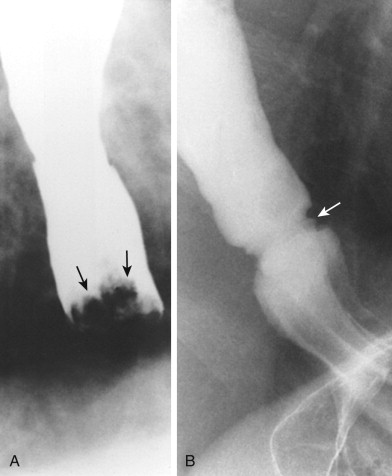
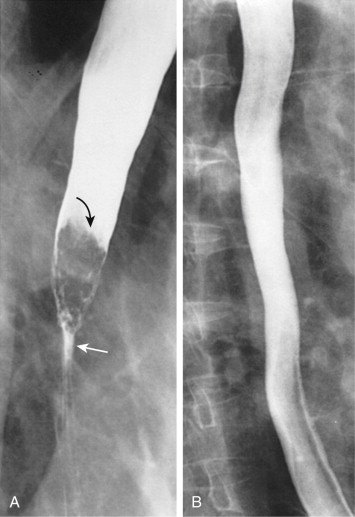
Esophageal perforation is a potential complication of food impaction that usually develops after the impacted bolus has been present longer than 24 hours, but this complication has been reported as early as 6 hours after the onset of impaction. Esophageal perforation may be manifested by focal extravasation of contrast material into the mediastinum at the site of impaction ( Fig. 25-13 ). Despite the risk of perforation, barium probably should be used as the initial contrast agent in patients with suspected food impaction because these individuals are also at higher risk for aspiration. Alternatively, endoscopy (rather than a barium study) may be performed as the first diagnostic test in this clinical setting because of potential difficulty visualizing and retrieving an impacted food bolus when retained barium is present above the impaction. The fluoroscopist should therefore consult with a gastroenterologist before performing a barium study on these patients.
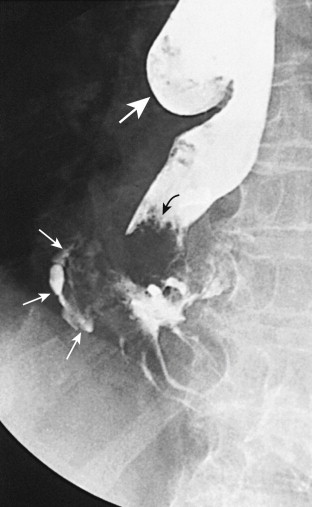
After the food impaction has been relieved, a follow-up esophagogram may be performed several weeks later to rule out an underlying Schatzki ring or peptic stricture as the cause of the impaction (see Fig. 25-11B ). Rarely, food impactions may be caused by malignant strictures or even by giant thoracic osteophytes or other structures impinging on the esophagus. In other patients, follow-up esophagography may reveal a normal underlying esophagus (see Fig. 25-12B ).
Treatment
When swallowed foreign bodies fail to pass spontaneously, some form of therapeutic intervention is required for their removal. Impacted foreign bodies in the pharynx or esophagus may be removed by endoscopy or the use of a wire basket or Foley catheter balloon under fluoroscopic guidance. These techniques appear to be safe and effective for extracting blunt foreign bodies from the esophagus. Alternatively, radiologists may attempt to relieve esophageal food impactions by a variety of noninvasive maneuvers. A single dose of 1 mg of intravenous (IV) glucagon sometimes facilitates passage of impacted food in the distal esophagus by relaxing the lower esophageal sphincter. Administration of gas-forming (i.e., effervescent) agents has also been advocated to distend the esophagus above an obstructing food bolus and facilitate passage of the bolus into the stomach. Combination therapy with glucagon, an effervescent agent, and water has been shown to relieve esophageal food impactions in about 70% of patients. Rarely, however, abrupt distention of the obstructed esophagus by a gas-forming agent may cause esophageal perforation, particularly if the obstructing bolus has been present longer than 24 hours. Because of the potential risk of esophageal perforation, it may be prudent to avoid such maneuvers in all patients with food impactions, instead referring them to endoscopy for removal of the obstructing food bolus.
Fistulas
Esophageal-Airway Fistula
Most esophageal-airway fistulas result from direct invasion of the tracheobronchial tree by advanced esophageal carcinomas. Tracheoesophageal or esophagobronchial fistulas (usually involving the left main bronchus) have been reported in 5% to 10% of patients with esophageal cancer. They tend to occur after radiation therapy, presumably because radiation-induced tumor necrosis accelerates fistula formation. Other esophageal-airway fistulas may be caused by esophageal instrumentation, endobronchial stents eroding into the esophagus, foreign bodies, blunt or penetrating injuries to the chest or, rarely, perforation of an esophageal diverticulum. Esophagobronchial fistulas may also be caused by tuberculosis, histoplasmosis, or other granulomatous diseases in which necrotic, caseating mediastinal lymph nodes erode into the esophagus and bronchial tree. Rarely, esophagobronchial fistulas may be congenital.
Patients with esophageal-airway fistulas often present with paroxysmal coughing after ingestion of liquids. Others develop recurrent aspiration pneumonia, hemoptysis, or a productive cough with particles of food in the sputum. These fistulas may be difficult to differentiate from tracheobronchial aspiration on clinical grounds.
When an esophageal-airway fistula is suspected, the fluoroscopic examination should be performed with barium rather than water-soluble contrast agents because the latter agents are hypotonic and may draw fluid into the lungs, causing severe, potentially fatal pulmonary edema. Most fistulas are readily demonstrated on barium studies and are found to arise within advanced, infiltrating esophageal carcinomas ( Fig. 25-14 ). Once barium has entered the trachea or bronchi, however, it can be coughed up into the proximal trachea or larynx, so delayed overhead radiographs may erroneously suggest tracheobronchial aspiration. The initial swallow should therefore be performed in a lateral projection (with a video recording of the pharynx) to differentiate a fistula from aspiration.
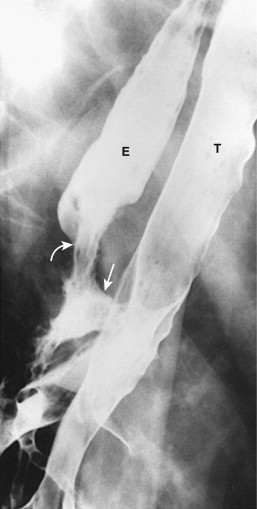
Esophagopleural Fistula
Esophagopleural fistulas are usually caused by previous surgery, esophageal instrumentation, radiation, or advanced esophageal carcinoma directly invading the pleural space. In contrast to patients with esophageal-airway fistulas, these individuals may have nonspecific clinical findings such as chest pain, fever, dysphagia, or dyspnea. When an esophagopleural fistula is suspected, the diagnosis can be confirmed by recovery of ingested methylene blue in fluid aspirated during thoracentesis. Nonoperative management of esophagopleural fistulas is associated with mortality rates approaching 100%, whereas surgical repair is associated with mortality rates of about 50%. Early diagnosis and surgical repair of these fistulas is therefore essential.
Chest radiographs may reveal a pleural effusion, pneumothorax, or hydropneumothorax on the side of the fistula ( Fig. 25-15A ). Pneumomediastinal or mediastinal widening is usually not present on chest radiographs because the mediastinum tends not to be directly involved by the fistula. When an esophagopleural fistula is suspected because of the clinical or plain film findings, a fluoroscopic examination using a water-soluble contrast agent should be performed to confirm the presence of a fistula and determine its precise location ( Fig. 25-15B ). CT may also be helpful for showing extraluminal collections of contrast medium, gas, or fluid in the pleural space from an esophagopleural fistula or even a gastropleural fistula after an esophagogastrectomy and gastric pull-through ( Fig. 25-16 ).
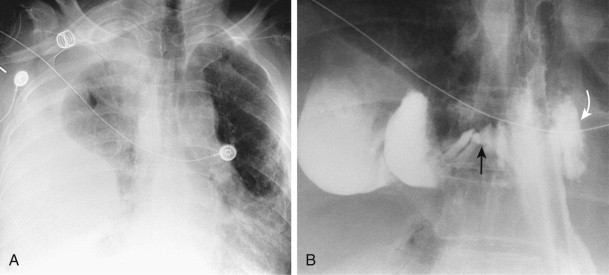
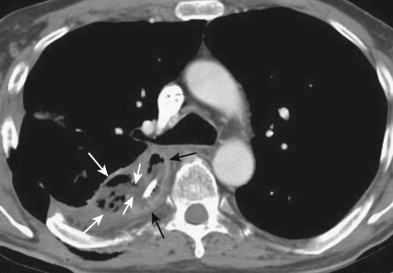
Occasionally, surgical disruption of the muscularis propria during a myotomy for achalasia, resection of a leiomyoma, or dissection of malignant tumor adherent to the esophagus may cause eccentric ballooning and thinning of the esophageal wall, resulting in the development of an esophagopleural fistula. In such cases, CT or esophagography with water-soluble contrast agents may reveal an esophagopleural fistula at the site of esophageal ballooning or thinning ( Fig. 25-17 ).
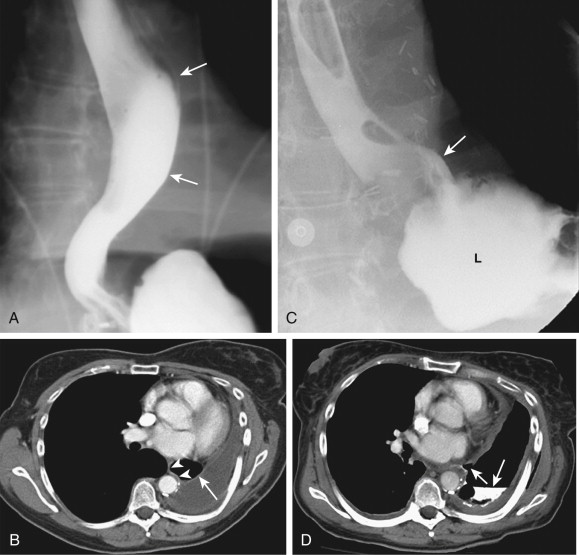

Stay updated, free articles. Join our Telegram channel

Full access? Get Clinical Tree





